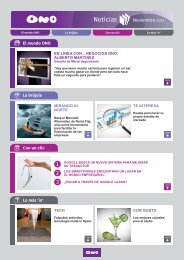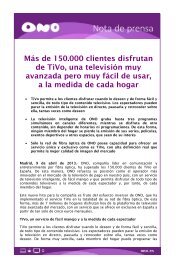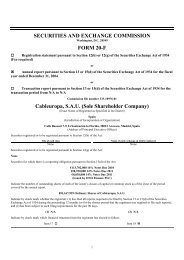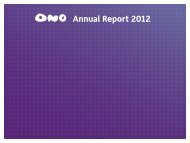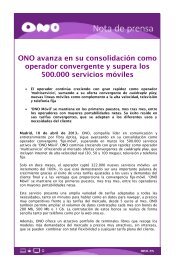Supplemental Disclosure Material - Ono
Supplemental Disclosure Material - Ono
Supplemental Disclosure Material - Ono
You also want an ePaper? Increase the reach of your titles
YUMPU automatically turns print PDFs into web optimized ePapers that Google loves.
provision of telecommunication services were liberalized and telecommunication networks could be exploited under free<br />
competition. Competition then increased as additional participants entered the market and challenged Telefónica’s dominance.<br />
Additional alternative players entered the market in the late 1990s and early 2000s. As a consequence of the adoption of the<br />
EU telecoms package in 2002, Law 11/1998 was replaced by Law 32/2003, General on Telecommunications, with the aim to<br />
increase competition in the sector reducing market regulatory barriers and allowing competition law to provide effective<br />
competition to the extent possible.<br />
The development of fiber as an alternative technology added more competition in the telecommunications market<br />
and provided consumers with an alternative to legacy copper technology. Spain’s fiber industry is relatively young compared<br />
to other European countries. Commercial networks were first constructed in the mid 1990s, as compared to most other<br />
European countries where fiber networks launched services in the 1970s and 1980s. ONO launched commercial services in<br />
1998. The industry has already undergone a period of consolidation, with ONO emerging as a market leader after its<br />
acquisition of Auna in 2005.<br />
The Spanish telecoms market is now moving towards convergence of voice, data and video networks and services.<br />
Telecom operators are rapidly introducing new products and services and trying to leverage their infrastructure by bundling<br />
services for consumers. The convergence process is driven by operators bundling services such as broadband internet access,<br />
television, fixed-line telephony and increasingly mobile into integrated offers (double, triple and quadruple play). In 2010, the<br />
number of bundled customers in the market increased by 782 thousand, which implies an 8.5% annual growth, to 10.0 million,<br />
according to CMT. At the end of 2010, approximately 49% of fixed telephony lines, 91% of internet services and 49% of<br />
pay-TV contracts were bundled with at least one other service. Spain is relatively more advanced than the EU average in the<br />
convergence process. The number of bundled packages (either double or triple play) in Spain, according to the Fifteenth<br />
Progress Report on the Single European Electronic Communications Market, reached 19.2% of the population in July 2009,<br />
which is higher than most other European countries. ONO is relatively advanced, with 40% of its fiber customers subscribing<br />
to a triple-play bundle as of March 31, 2012.<br />
Bundled offers per type as % of population, July 2009<br />
28.6%<br />
27.1%<br />
22.4% 21.8%<br />
19.2% 18.8%<br />
15.5%<br />
13.9% 13.2%<br />
9.2% 9.0% 8.5% 8.1% 8.0% 6.9%<br />
3.4% 3.2%<br />
1.2%<br />
Netherlands<br />
Germany<br />
France<br />
Luxembourg<br />
Spain<br />
UK<br />
Estonia<br />
Italy<br />
Ireland<br />
Finland<br />
Belgium<br />
Greece<br />
Slovenia<br />
Sweden<br />
Poland<br />
Cyprus<br />
Czech Republic<br />
Bulgaria<br />
Double play<br />
Triple play<br />
Source: Fifteenth Progress Report on the Single European Electronic Communications Market, 2010<br />
Technologies<br />
Telecommunication and television needs of the consumers in the Spanish market are mainly addressed through<br />
PSTN (Public Switched Telephone Network), fiber, satellite, DTT (Digital Terrestrial Television) and mobile technologies.<br />
PSTN<br />
Telefónica, as the incumbent operator, has a PSTN network that covers the majority of Spain for fixed-line services<br />
and fixed broadband (xDSL) services. Telefónica is also upgrading parts of its network to VDSL, allowing it to offer higher<br />
speed broadband services.<br />
The General Law on Telecommunications (Law 32/2003, of November 3) and accompanying regulations impose<br />
obligations on Telefónica to unbundle its PSTN local loops. Alternative telecom operators are allowed to use Telefónica’s<br />
copper-based network to provide their own services through a process referred to as “unbundling of the local loop” (“ULL”).<br />
ONO uses ULL (ADSL) as a complement to its fiber network in those areas where it does not have fiber coverage. Other<br />
alternative telecom operators using ULL (ADSL) in Spain include Vodafone, Orange and Jazztel. ULL (ADSL) operators<br />
44





